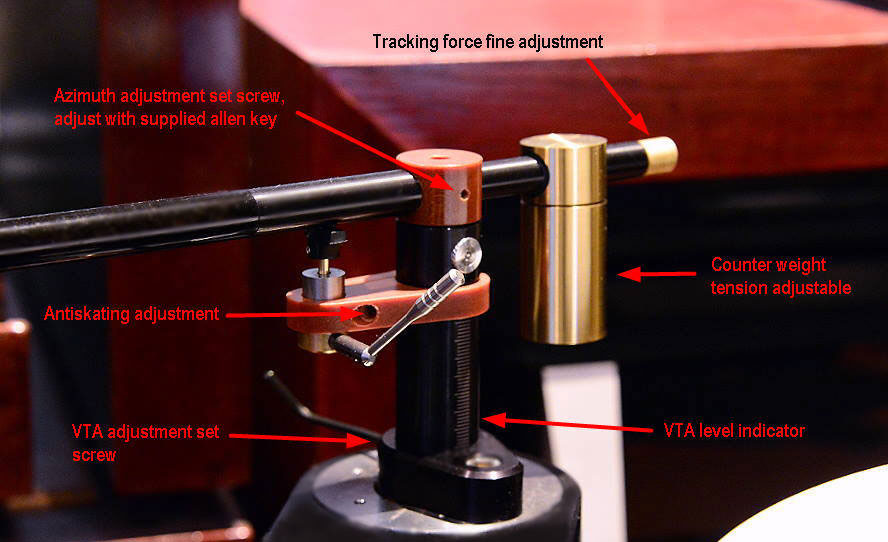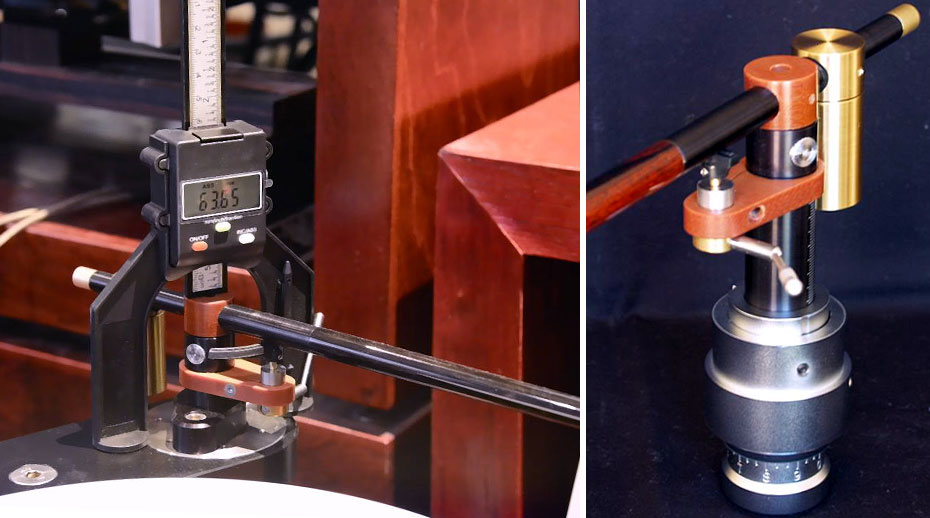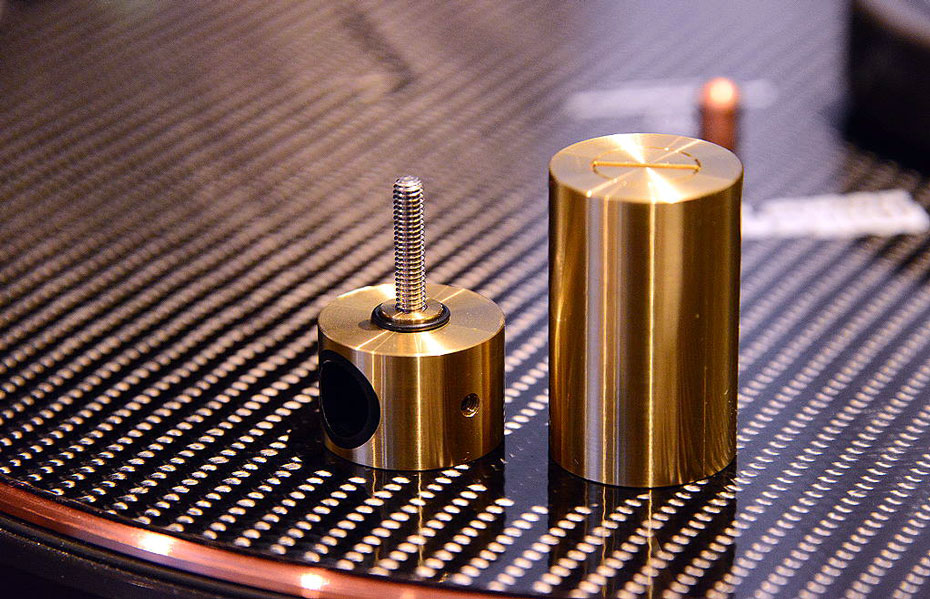Next, we will look at each of the adjustment parameters in detail: Azimuth, VTA, VTF and Anti-skating.
The elongated shape of the TA-1’s counterweight gives the impression that the azimuth is adjusted by swinging it off to one side, causing azimuth to change by weight redistribution. This is true in the case of unipivoted arms such as the VPI JMW, or the Moerch UP-4. In the TA-1 however, the “Raised Hyper Ceramic Bearing” movement behaves very much like a Gimball Pivoted Arm, permitting only vertical and horizontal movement but not multidirectional or diagonal movement, so the tonearm does not wobble from side to side horizontally; swinging the counterweight will therefore have no effect on the azimuth.
Azimuth is adjusted by loosening the set screw on the pivot column as indicated on the diagram, and rotating the entire arm tube clockwise or counter clockwise, reminiscent of the manner in which the Kuzma 4 Point arm adjusts azimuth. But because there are no markings or indicators on the arm tube, the adjustable azimuth is therefore neither replicable nor repeatable in the sense that it will be difficult to know how far you have rotated or whether you are returning to the same spot. With my distortion analyzer and the Analog Productions Test LP, I adjust azimuth by measuring crosstalk between channels, and the optimal point is achieved when this number is equal between both channels. In reality, if you can achieve a difference of less than -0.25dB to -0.5 dB between channels, the accuracy is already of a very high order, one that is however, unachievable with visual methods, or even with electronic tools like the Fozgometer. With the non-repeatable azimuth adjustment of TA-1, small rotations of the armtube can lead to large changes in azimuth, so the exercise can be both frustrating and time consuming. It took me more than two 2 hours of fine tuning before I was able to achieve an optimum azimuth reading.
Vertical Tracking Angle (VTA) on the TA-1 is adjustable by loosening the set screw as shown on the above diagrams. Changes in VTA height are indicated by horizontal lines marked onto the pivot column. An Intermodulation Distortion Analyzer, a method about which I will not go into great details here, can measure the effects of changes in height of the pivot column of less than 0.5mm; this method of setting VTA requires a high level of accuracy. Therefore, any method which relies on eyeballing rough markings on the column will simply not be accurate enough to achieve an optimal level of precision. Instead, I came up with two alternative solutions.
The first solution is to employ the use of a “Digital Height Setting Guage” which can be found on eBay for approximately $15. I bought mine at Lee Valley Tools for $12.50. This useful little tool will allow you to perform repeatable adjustments to the VTA by accurately measuring changes in the height of the pivot column, accurate to within 0.05 mm (see picture below). Considering the alternative is to use a stack of cards or to read rough markings on the column, I much prefer spending $12.50 on a measuring gauge.
A more expensive but perhaps permanent solution will be to order the VTA Adjuster from Chris Brady of Teres Audio for $250, and assuming he is willing to make one for you. The VTA Adjuster will replace the mounting collar, and will allow you to perform repeatable VTA changes through the turn dial accurate to 1/1000 of a millimetre. With the VTA adjuster, you can adjust VTA on-the-fly even with the record playing. Unfortunately, the adapter will only work for turntables with separate armboards such as the Verdier, TW Raven AC, or the Clearaudio Innovation. If you have a table in which the armboard is not separated from the plinth, such as the Artemis Lab’s own SA-1, you will not be able to install this adapter.
Vertical Tracking Force for the TA-1 is adjustable by sliding the counterweight forward and backward to an approximate range. The fine adjustment knob located at the very end of the armwand will allow you to narrow down the VTF to within fractions of a gram. It should be mentioned that an ingenious design has been incorporated into the counterweight of this tonearm. The counterweight has a bottom element that can be screwed onto its upper part which is polymer damped, allowing the tightness to be fine tuned. According to Sean, altering the tightness of this bottom element may have an effect on the resonance frequency of the armwand, which may come in handy should there be a compliance mismatch. Notably, my own experimentation tells me that changing the tightness of the bottom element does seem to have an effect on the low frequency presentation. The bottom element also has an inset (screwed in from the bottom) that can be exchanged for a lighter or a heavier cylinder, allowing for an increase or decrease of total counterweight mass without altering the overall mass distribution of the arm.
Last but not least, the TA-1 allows users to adjust anti-skating by turning the set screw as indicated on the diagram. The adjustment screw increases or decreases the anti-skating which operates through a magnetic mechanism, exerting a force of up to 2.3 gr. of anti-skating compensation. On all three of the cartridges (Clearaudio Goldfinger, Lyra Atlas, and Benz Micro LP) I mounted on the tonearm, the optimal point required almost no anti-skating force as determined by a method which measures L/R Channel distortion difference with a distortion analyzer, which I will not go into great detail about here.
- ← Previous page
- (Page 3 of 4)
- Next page →





Hi, a great Review from a Music Lover. I´m from Austria the land with the great “Sophien hall” for record the best records from DECCA.
So i´m a classsical music lover and have now the possibility to buy a used 4point or a Schroeder CB. It should present big Orchestra without compression, or small quartets, tonal real instruments, fine breathe & air of the music
What would you suggest?
many thanks Gerhard